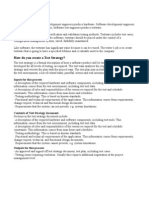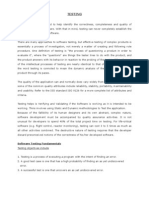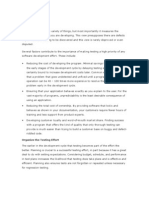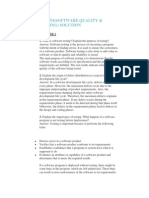Test Strategy - Wikipedia, ...
Test Strategy - Wikipedia, ...
Uploaded by
ruwaghmareCopyright:
Available Formats
Test Strategy - Wikipedia, ...
Test Strategy - Wikipedia, ...
Uploaded by
ruwaghmareCopyright
Available Formats
Share this document
Did you find this document useful?
Is this content inappropriate?
Copyright:
Available Formats
Test Strategy - Wikipedia, ...
Test Strategy - Wikipedia, ...
Uploaded by
ruwaghmareCopyright:
Available Formats
Test strategy - Wikipedia, the free encyclopedia
http://en.wikipedia.org/wiki/Test_strategy
Test strategy
From Wikipedia, the free encyclopedia
Compare with Test plan. A test strategy is an outline that describes the testing approach of the software development cycle. It is created to inform project managers, testers, and developers about some key issues of the testing process. This includes the testing objective, methods of testing new functions, total time and resources required for the project, and the testing environment. Test strategies describes how the product risks of the stakeholders are mitigated at the test-level, which types of test are to be performed, and which entry and exit criteria apply. They are created based on development design documents. System design documents are primarily used and occasionally, conceptual design documents may be referred to. Design documents describe the functionality of the software to be enabled in the upcoming release. For every stage of development design, a corresponding test strategy should be created to test the new feature sets.
Contents
1 Test Levels 2 Roles and Responsibilities 3 Environment Requirements 4 Testing Tools 5 Risks and Mitigation 6 Test Schedule 7 Regression Test Approach 8 Test Groups 9 Test Priorities 10 Test Status Collections and Reporting 11 Test Records Maintenance 12 Requirements traceability matrix 13 Test Summary 14 See also 15 References
Test Levels
The test strategy describes the test level to be performed. There are primarily three levels of testing: unit testing, integration testing, and system testing. In most software development organizations, the developers are responsible for unit testing. Individual testers or test teams are responsible for integration and system testing.
Roles and Responsibilities
The roles and responsibilities of test leader, individual testers, project manager are to be clearly defined at a project level in this section. This may not have names associated: but the role has to be very clearly defined. Testing strategies should be reviewed by the developers. They should also be reviewed by test leads for all levels of testing to make sure the coverage is complete yet not overlapping. Both the testing manager and the
1 of 4
3/5/2012 4:34 PM
Test strategy - Wikipedia, the free encyclopedia
http://en.wikipedia.org/wiki/Test_strategy
development managers should approve the test strategy before testing can begin.
Environment Requirements
Environment requirements are an important part of the test strategy. It describes what operating systems are used for testing. It also clearly informs the necessary OS patch levels and security updates required. For example, a certain test plan may require Windows XP Service Pack 3 to be installed as a prerequisite for testing.
Testing Tools
There are two methods used in executing test cases: manual and automated. Depending on the nature of the testing, it is usually the case that a combination of manual and automated testing is the best testing method.
Risks and Mitigation
Any risks that will affect the testing process must be listed along with the mitigation. By documenting a risk, its occurrence can be anticipated well ahead of time. Proactive action may be taken to prevent it from occurring, or to mitigate its damage. Sample risks are dependency of completion of coding done by sub-contractors, or capability of testing tools.
Test Schedule
A test plan should make an estimation of how long it will take to complete the testing phase. There are many requirements to complete testing phases. First, testers have to execute all test cases at least once. Furthermore, if a defect was found, the developers will need to fix the problem. The testers should then re-test the failed test case until it is functioning correctly. Last but not the least, the tester need to conduct regression testing towards the end of the cycle to make sure the developers did not accidentally break parts of the software while fixing another part. This can occur on test cases that were previously functioning properly. The test schedule should also document the number of testers available for testing. If possible, assign test cases to each tester. It is often difficult to make an accurate approximation of the test schedule since the testing phase involves many uncertainties. Planners should take into account the extra time needed to accommodate contingent issues. One way to make this approximation is to look at the time needed by the previous releases of the software. If the software is new, multiplying the initial testing schedule approximation by two is a good way to start.
Regression Test Approach
When a particular problem is identified, the programs will be debugged and the fix will be done to the program. To make sure that the fix works, the program will be tested again for that criteria. Regression test will make sure that one fix does not create some other problems in that program or in any other interface. So, a set of related test cases may have to be repeated again, to make sure that nothing else is affected by a particular fix. How this is going to be carried out must be elaborated in this section. In some companies, whenever there is a fix in one unit, all unit test cases for that unit will be repeated, to achieve a higher level of quality.
2 of 4
3/5/2012 4:34 PM
Test strategy - Wikipedia, the free encyclopedia
http://en.wikipedia.org/wiki/Test_strategy
Test Groups
From the list of requirements, we can identify related areas, whose functionality is similar. These areas are the test groups. For example, in a railway reservation system, anything related to ticket booking is a functional group; anything related with report generation is a functional group. Same way, we have to identify the test groups based on the functionality aspect.
Test Priorities
Among test cases, we need to establish priorities. While testing software projects, certain test cases will be treated as the most important ones and if they fail, the product cannot be released. Some other test cases may be treated like cosmetic and if they fail, we can release the product without much compromise on the functionality. This priority levels must be clearly stated. These may be mapped to the test groups also.
Test Status Collections and Reporting
When test cases are executed, the test leader and the project manager must know, where exactly the project stands in terms of testing activities. To know where the project stands, the inputs from the individual testers must come to the test leader. This will include, what test cases are executed, how long it took, how many test cases passed, how many failed, and how many are not executable. Also, how often the project collects the status is to be clearly stated. Some projects will have a practice of collecting the status on a daily basis or weekly basis.
Test Records Maintenance
When the test cases are executed, we need to keep track of the execution details like when it is executed, who did it, how long it took, what is the result etc. This data must be available to the test leader and the project manager, along with all the team members, in a central location. This may be stored in a specific directory in a central server and the document must say clearly about the locations and the directories. The naming convention for the documents and files must also be mentioned.
Requirements traceability matrix
Main article: Traceability matrix Ideally, the software must completely satisfy the set of requirements. From design, each requirement must be addressed in every single document in the software process. The documents include the HLD, LLD, source codes, unit test cases, integration test cases and the system test cases. In a requirements traceability matrix, the rows will have the requirements. The columns represent each document. Intersecting cells are marked when a document addresses a particular requirement with information related to the requirement ID in the document. Ideally, if every requirement is addressed in every single document, all the individual cells have valid section ids or names filled in. Then we know that every requirement is addressed. If any cells are empty, it represents that a requirement has not been correctly addressed.
Test Summary
The senior management may like to have test summary on a weekly or monthly basis. If the project is very critical, they may need it even on daily basis. This section must address what kind of test summary reports will be produced for the senior management along with the frequency.
3 of 4
3/5/2012 4:34 PM
Test strategy - Wikipedia, the free encyclopedia
http://en.wikipedia.org/wiki/Test_strategy
The test strategy must give a clear vision of what the testing team will do for the whole project for the entire duration. This document will/may be presented to the client also, if needed. The person, who prepares this document, must be functionally strong in the product domain, with very good experience, as this is the document that is going to drive the entire team for the testing activities. Test strategy must be clearly explained to the testing team members right at the beginning of the project.
See also
Software testing Test case Risk-based testing
References
Ammann, Paul and Offutt, Jeff. Introduction to software testing. New York: Cambridge University Press, 2008 Bach, James (1999). "Test Strategy" (http://www.satisfice.com/presentations/strategy.pdf) . http://www.satisfice.com/presentations/strategy.pdf. Retrieved October 31, 2011. Dasso, Aristides. Verification, validation and testing in software engineering. Hershey, PA: Idea Group Pub., 2007 Retrieved from "http://en.wikipedia.org/w/index.php?title=Test_strategy&oldid=475810027" Categories: Software testing This page was last modified on 8 February 2012 at 19:27. Text is available under the Creative Commons Attribution-ShareAlike License; additional terms may apply. See Terms of use for details. Wikipedia is a registered trademark of the Wikimedia Foundation, Inc., a non-profit organization.
4 of 4
3/5/2012 4:34 PM
You might also like
- ISTQB Certified Tester Foundation Level Practice Exam QuestionsFrom EverandISTQB Certified Tester Foundation Level Practice Exam QuestionsRating: 5 out of 5 stars5/5 (1)
- Introduction To Software Testing Life CycleDocument11 pagesIntroduction To Software Testing Life CycleKirti UpadhyayNo ratings yet
- How To Prepare A Good Test Strategy Document: Step #1: Scope and OverviewDocument4 pagesHow To Prepare A Good Test Strategy Document: Step #1: Scope and OverviewPewee VentanillaNo ratings yet
- Interview Questions On Data Base TestingDocument8 pagesInterview Questions On Data Base TestingRajeshdotnetNo ratings yet
- Termpaper Synopsis OF CSE-302 (SAD) : Submitted To: Submitted By: Miss. Neha Gaurav Khara Mam RJ1802 A15Document6 pagesTermpaper Synopsis OF CSE-302 (SAD) : Submitted To: Submitted By: Miss. Neha Gaurav Khara Mam RJ1802 A15Harpreet SinghNo ratings yet
- What Is A Test Case?Document23 pagesWhat Is A Test Case?jayanthnaiduNo ratings yet
- Testware:: How Do You Create A Test Strategy?Document10 pagesTestware:: How Do You Create A Test Strategy?Dhananjayan BadriNo ratings yet
- Testing: Testing Is A Process Used To Help Identify The Correctness, Completeness and Quality ofDocument25 pagesTesting: Testing Is A Process Used To Help Identify The Correctness, Completeness and Quality ofdfdfdNo ratings yet
- Unit 1Document19 pagesUnit 1DineshNo ratings yet
- LO1: Prepare For TestDocument5 pagesLO1: Prepare For TestmengistuNo ratings yet
- Testing Documentation: Documentation As Part of ProcessDocument3 pagesTesting Documentation: Documentation As Part of ProcesspepeluNo ratings yet
- Interview Questions - BasicsDocument39 pagesInterview Questions - Basicsapi-26345612No ratings yet
- Unit 4 Software TestingDocument12 pagesUnit 4 Software Testingwasnikbadal4No ratings yet
- Test Plan TemplateDocument6 pagesTest Plan TemplateОксана ЧунисNo ratings yet
- ST A Unit 1Document20 pagesST A Unit 1geetha.pvNo ratings yet
- Software Testing Life Cycle (STLC)Document10 pagesSoftware Testing Life Cycle (STLC)rony12No ratings yet
- SW TestingDocument112 pagesSW Testingyours_raj143No ratings yet
- Chapter 3 Test Management14 Marks Final With Questions of Msbte-Papers-EditedDocument27 pagesChapter 3 Test Management14 Marks Final With Questions of Msbte-Papers-EditedPreet ShahNo ratings yet
- Testing NotesDocument77 pagesTesting NotesHimanshu GoyalNo ratings yet
- Software Testing Process - What Happens in Software TestingDocument10 pagesSoftware Testing Process - What Happens in Software Testingrony12No ratings yet
- Software Testing Documentation: Test PlanDocument3 pagesSoftware Testing Documentation: Test PlanNeo KoolNo ratings yet
- Test Plan TemplateDocument9 pagesTest Plan TemplateRodica Dan100% (1)
- Unit4Part1pdf 2024 10 04 21 49 25Document51 pagesUnit4Part1pdf 2024 10 04 21 49 25amethiya vishalNo ratings yet
- Sta Test-IvDocument6 pagesSta Test-Ivmanikandan02.04.2003No ratings yet
- Introduction To Software Testing - v19Document34 pagesIntroduction To Software Testing - v19anumathewsNo ratings yet
- Testing QuestionsDocument4 pagesTesting QuestionsvijaythiruveedhulaNo ratings yet
- Planning A Test and TOSDocument6 pagesPlanning A Test and TOSMichelle FuentecillaNo ratings yet
- Session 9: Test Management - Closing: ISYS6338 - Testing and System ImplementationDocument46 pagesSession 9: Test Management - Closing: ISYS6338 - Testing and System ImplementationWeebMeDaddyNo ratings yet
- IEEE829 Test Plan Format SampleDocument17 pagesIEEE829 Test Plan Format Samplealakh400No ratings yet
- Software Testing-1Document29 pagesSoftware Testing-1rabiyab082No ratings yet
- Software Testing For Project ReportDocument15 pagesSoftware Testing For Project ReportKamal AcharyaNo ratings yet
- Latent DefectDocument6 pagesLatent DefectManjit MalikNo ratings yet
- Presentation 3Document37 pagesPresentation 3Huzef AttarNo ratings yet
- Software Testing and QA Interview Questions With AnswersDocument22 pagesSoftware Testing and QA Interview Questions With Answersgloria34_No ratings yet
- Software Testing Is A Process of Executing A Program or Application With The Intent of FindingDocument9 pagesSoftware Testing Is A Process of Executing A Program or Application With The Intent of Findingmalik ArshNo ratings yet
- Software Testing Life CycleDocument5 pagesSoftware Testing Life CycleAmina Muhammad AminNo ratings yet
- Testing Overview Purpose of TestingDocument7 pagesTesting Overview Purpose of TestingAmit RathiNo ratings yet
- Agile TestDocument4 pagesAgile TestautrangmNo ratings yet
- 3-1 Rit-Csm-Se-Q&a Unit-4Document31 pages3-1 Rit-Csm-Se-Q&a Unit-4GokulNo ratings yet
- Software Testing All Questions and AnswersDocument98 pagesSoftware Testing All Questions and AnswersSeun -nuga DanielNo ratings yet
- Bsit-54 (Software Quality & Testing) Solution: Chapter-1 1. What Is Software Testing? Explain The Purpose of Testing?Document25 pagesBsit-54 (Software Quality & Testing) Solution: Chapter-1 1. What Is Software Testing? Explain The Purpose of Testing?monu52No ratings yet
- Methods of Software TestingDocument12 pagesMethods of Software TestingSai RaazNo ratings yet
- Software ValidationDocument20 pagesSoftware Validationradhye radhyeNo ratings yet
- TestingDocument26 pagesTestingDivyam BhushanNo ratings yet
- ISTQB Chapter 1 SummaryDocument8 pagesISTQB Chapter 1 SummaryViolet100% (3)
- MSC 2nd Soft TestingDocument31 pagesMSC 2nd Soft Testingjyotikedar0705No ratings yet
- Testing Strategy: Author: PSC ConsultingDocument20 pagesTesting Strategy: Author: PSC ConsultingSadar Cm100% (1)
- Software Testing Sessional-2Document19 pagesSoftware Testing Sessional-2Mohit GuptaNo ratings yet
- Explain in Detail About The Software Testing and Its Development ProcessDocument9 pagesExplain in Detail About The Software Testing and Its Development ProcessKumar ShiveshwarNo ratings yet
- Testing PlanDocument7 pagesTesting PlanSima DhoreNo ratings yet
- Software Testing All Questions and Answers PDFDocument98 pagesSoftware Testing All Questions and Answers PDFseunnuga93No ratings yet
- Functional Testing With ExamplesDocument10 pagesFunctional Testing With ExamplesSimonaNo ratings yet
- Unit-6 Testing PoliciesDocument10 pagesUnit-6 Testing PoliciesRavi RavalNo ratings yet
- A Survey of Effective and Efficient Software TestingDocument9 pagesA Survey of Effective and Efficient Software Testinggolam rabbiNo ratings yet
- Software Testing Revision NotesDocument12 pagesSoftware Testing Revision NotesVenkatesh VuruthalluNo ratings yet
- Manual Testing Interview Questions (General Testing) : What Does Software Testing Mean?Document30 pagesManual Testing Interview Questions (General Testing) : What Does Software Testing Mean?April Ubay AlibayanNo ratings yet
- ISTQB Certified Tester Advanced Level Test Manager (CTAL-TM): Practice Questions Syllabus 2012From EverandISTQB Certified Tester Advanced Level Test Manager (CTAL-TM): Practice Questions Syllabus 2012No ratings yet
- Software Testing: A Guide to Testing Mobile Apps, Websites, and GamesFrom EverandSoftware Testing: A Guide to Testing Mobile Apps, Websites, and GamesRating: 4.5 out of 5 stars4.5/5 (3)
- Automated Software Testing Interview Questions You'll Most Likely Be AskedFrom EverandAutomated Software Testing Interview Questions You'll Most Likely Be AskedNo ratings yet
- Iamge Video Compression V2Document29 pagesIamge Video Compression V2MOHNo ratings yet
- EepromDocument7 pagesEepromZoranNo ratings yet
- 1) Run The Convert Command (In Our Case We Ran It On Source)Document31 pages1) Run The Convert Command (In Our Case We Ran It On Source)sachinappsdbaNo ratings yet
- Offline LRMDS Installation Guide - For DCP TestDocument8 pagesOffline LRMDS Installation Guide - For DCP TestGerald Calicdan ArugayNo ratings yet
- MS Word 2007 Shortcut KeysDocument24 pagesMS Word 2007 Shortcut KeysSivakrishna UmmaletiNo ratings yet
- Tiktok Ban Met With Cold Reaction British English StudentDocument9 pagesTiktok Ban Met With Cold Reaction British English StudentGlady VatorNo ratings yet
- Comparison of LinuxDocument3 pagesComparison of LinuxJc AlbaricoNo ratings yet
- Sub 37 Update Instructions v1.1.0Document7 pagesSub 37 Update Instructions v1.1.0Toms PoišsNo ratings yet
- Training in BhubaneswarDocument11 pagesTraining in Bhubaneswardotnet123No ratings yet
- DDW Assignment Spring 2024 - Winter 2024 (6751)Document6 pagesDDW Assignment Spring 2024 - Winter 2024 (6751)Kennedy Bernardo PhiriNo ratings yet
- Marantz PMD671Document2 pagesMarantz PMD671Цар МарNo ratings yet
- Informatica Interview Question Answers CollectionDocument4 pagesInformatica Interview Question Answers CollectionSweta SinghNo ratings yet
- RIADocument5 pagesRIAArchana ARCHANANo ratings yet
- LogcatDocument22 pagesLogcatredwise088No ratings yet
- SAP FICO Support Consultant DocumentDocument35 pagesSAP FICO Support Consultant DocumentRapalli Rams100% (5)
- Productivity Tools For Wootlab-1Document27 pagesProductivity Tools For Wootlab-1nwankwo chukwuebukaNo ratings yet
- 600-RN-0012 WBFDDK ReleaseNotes 4 3 205 0Document6 pages600-RN-0012 WBFDDK ReleaseNotes 4 3 205 0Max PlanckNo ratings yet
- Website Audience and Content Packet WP ClassDocument16 pagesWebsite Audience and Content Packet WP ClassEdgar RojasNo ratings yet
- Photoshop InstructionsDocument1 pagePhotoshop InstructionsPhil Law SophoNo ratings yet
- HTML NotesDocument15 pagesHTML NotesTusshar GuravNo ratings yet
- Confluence Qps NL Display KB 4 Quick Start QINSy ReplayDocument15 pagesConfluence Qps NL Display KB 4 Quick Start QINSy Replayshrikant_i4u1164No ratings yet
- Travel With Glance: at Your ServiceDocument18 pagesTravel With Glance: at Your ServiceAmanPreet SidhuNo ratings yet
- Parts of VS IDEDocument7 pagesParts of VS IDEParkKyleNo ratings yet
- Smod & CmodDocument4 pagesSmod & Cmodarpitadutta123No ratings yet
- Social Media Lead Generation StrategyDocument20 pagesSocial Media Lead Generation Strategymubtada100% (1)
- Readme - MS Office 2007 Portable (6-In-1)Document2 pagesReadme - MS Office 2007 Portable (6-In-1)'Steph HerbertNo ratings yet
- Online Restaurant System Management: Ux-Ui Design ProjectDocument9 pagesOnline Restaurant System Management: Ux-Ui Design ProjectLawrence Del ayreNo ratings yet
- Apps and Services - Guide PDFDocument5 pagesApps and Services - Guide PDFZephir AWTNo ratings yet
- The Definitive Guide To SEO in 2021: New Strategies That Are Working GreatDocument74 pagesThe Definitive Guide To SEO in 2021: New Strategies That Are Working GreatNikki R GNo ratings yet
- RESTORE DATABASE - IBM DB2 9.7 For Linux, UNIX, and WindowsDocument13 pagesRESTORE DATABASE - IBM DB2 9.7 For Linux, UNIX, and Windowsolippo19No ratings yet

























































































